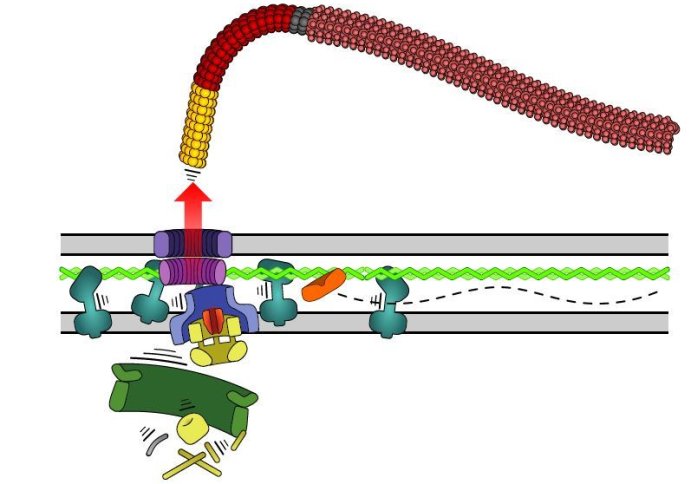Starving bacteria can eject their tails to save energy and stay alive

When nutrients are dangerously low, a group of bacteria have been found to take the drastic measure of getting rid of their tails.
Some bacteria use tails, or flagella, to swim through liquids – including those in our bodies. However, new research published today in PLOS Biology reveals a surprisingly drastic measure taken by some bacteria when facing starvation: they eject their flagella, leaving themselves paralyzed, but conserving energy so they can stay alive.
Not only had the bacteria ejected their flagella, they had plugged the hole it left behind. This suggested to us it was a deliberate action. Josie Ferreira
The research team, led by Imperial College London in collaboration with researchers from the Francis Crick Institute, the University of Leiden, and Justus-Liebig-Universität Giessen, say this is the first time such curious behaviour has been observed in bacteria.
The serendipitous discovery was made when the team were collecting detailed images of the ‘motors’ that drive flagella in a group of bacteria that includes various harmful species, including Vibrio cholerae, which causes cholera.
They saw some instances where part of the motor ‘housing’ was present in the membrane of a bacterium, but not the motor or flagellum itself. This suggested two possibilities: either they had caught an image of the motor-flagellum complex as it was being assembled, or as it was being disassembled.
Deliberate ejection
First author Josie Ferreira, from the Department of Life Sciences at Imperial, said: “Before we started our experiments, we thought we had caught the bacteria in the process of assembling their motor-flagella complexes. To our surprise, we found the opposite: not only had the bacteria ejected their flagella, they had plugged the hole it left behind. This suggested to us it was a deliberate action.”
Bacterial use their flagella to get around, even swimming through thick gut mucus as in the case of food-poisoning bacterium Campylobacter jejuni. However, flagella are costly to build and power, and constantly grow throughout the bacterium’s life, using up a lot of resources.
The team found that bacteria placed in environments that lacked nutrients ejected their flagella into the growth medium. The discarded flagella were complete, including the adaptor structure that connects flagella to their motors, suggesting that they were ejected whole from their base, and not broken off.
Lead author Dr Morgan Beeby, from the Department of Life Sciences at Imperial, said: “The bacteria’s actions appear to be deliberate. It’s not like when our fingers or toes drop off from frostbite – it’s more a calculated act like mountaineer Aron Ralston cutting off his arm in the film 127 Hours to free himself from under a rock.”
Messy evolution
Bacteria have been observed swimming more slowly when nutrients are low, but this is the first time they have been observed jettisoning their flagella completely in a bid to save energy.
The team say that determining what mechanism harmful bacteria use to eject their flagella could suggest new targets for drugs that force them to push the eject button.
Dr Beeby also says that although the bacteria have evolved a clear mechanism for ejecting flagella and plugging the gap, the process shows how irrational and messy evolution can be. He said: “Evolution is not neat or tidy: leaving the motor structure behind in the membrane is a kind of ‘bacterial clutter’ that the bacteria close the door on. While an inelegant solution, their molecular clutter doesn’t hurt them.”
-
‘γ-proteobacteria eject their polar flagella under nutrient depletion, retaining flagellar motor relic structures’ by Josie L. Ferreira, Forson Z. Gao, Florian M. Rossmann, Andrea Nans, Susanne Brenzinger, Rohola Hosseini, Amanda Wilson, Ariane Briegel, Kai M. Thormann, Peter B. Rosenthal, and Morgan Beeby is published in PLOS Biology.
Article supporters
Article text (excluding photos or graphics) © Imperial College London.
Photos and graphics subject to third party copyright used with permission or © Imperial College London.
Reporter
Hayley Dunning
Communications Division



